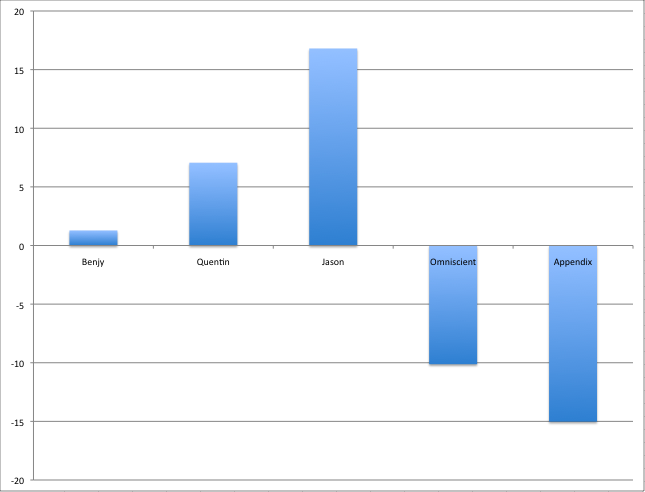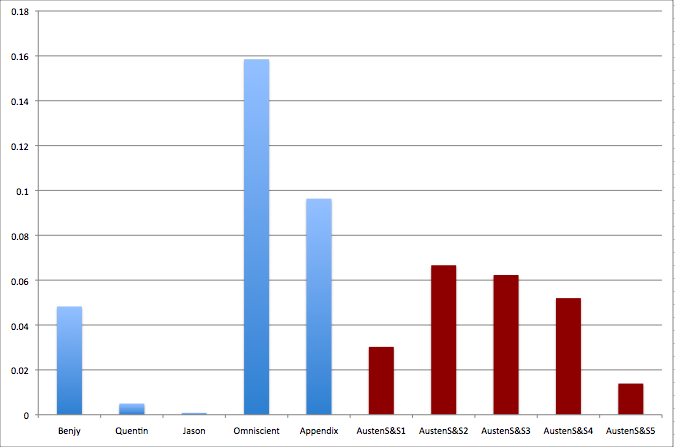
This project aims to determine what elements contribute to an author's style, how that style and changes in that style influence the reading of the novel, and how or if we can quantify these elements of style. Readers of William Faulkner's The Sound and the Fury understand that the work contains at least five different "voices," if the Appendix that Faulkner wrote after the book's initial publication is included, namely those of Benjy, Quentin, Jason, the Omniscient narrator of the fourth section, and then the somewhat mysterious voice of the Appendix that some have called Faulkner's own voice. We use The Sound and the Fury as a test bed for stylistic analysis of narrative and authorial voice because it contains these multiple voices, which perhaps result in multiple styles. To examine these different voices, we use humanities computing techniques, including authorship attribution, to investigate narrative voice and to explore the extent to which Faulkner is able to "create" distinct narrative styles within The Sound and the Fury.
We were prompted to this end by the objectives outlined in our final assignment for the class 'English 153H - Digital Humanities: Beyond the Book' taught by English Professor Matthew Jockers. The project required us to encode a literary text, develop hypotheses regarding some trend or theme in the novel, create tools that would allow us to investigate these hypotheses, and finally, design a website that presents all aspects of our project. The work was divided between five Stanford undergraduate students of varying Humanities Majors: Caitlin Crandell, Emily Gong, Rachel Kraus, Tiffany Lieu, and Jacob Mason-Marshall.
An important aspect of our project is the interplay between a traditional reading of a text and computer-based methodology. In our first two experiments we created hypotheses based on initial human readings and then tested these hypotheses using computer-generated data. Our third experiment worked in the reverse. We first asked a question that we could never answer without using statistical techniques without making predictions and then generated data to respond to this question. We next looked at what the data suggested and explored what new insights it could offer us, as readers, about the text. In our experiment we use the comparison between our observations, a computer's analysis, and our interpretations of that analysis to investigate what role computer-based methodology might play in a conventional study of literature. In this way we are both the investigators and the subjects of our experiment. This also leads to an interesting comparison between objective and subjective literary analysis. The former is only possible using computing, since a human reading is always subjective. Our first two experiments move from subjective to objective, testing a human prediction against statistical data. However, in our third experiment we sought to transform our text into a new statistical medium and work in a reverse order–starting with objective, and moving to subjective analysis. Using our tool of authorship attribution to measure narrative style and narrative dissonance, we compare our objective and subjective conclusions to determine what aspects truly contribute to style.
These are our initial, "subjective" hypotheses after our first readings:
We found that the variability in structure, punctuation, vocabulary, and paragraph length are the most important factors in distinguishing the sections and their narrative voices from one another. These elements are also the most significant because the sections all deal with the same content–Caddy's promiscuity, a family dealing with a retarded child, and a family suicide among other things–but structurally give very different accounts. This variability gives the reader insight into the personalities and psyches of the narrators. Benjy's simple language, structural and temporal inconsistency, and reporter-like account reveal his role as a passive agent in his own life, yet also give a unique insight and intuition into the workings of his family. While Benjy narrates in short, clipped sentences, Quentin does so in endless paragraphs that often don't even include punctuation, reflecting his utter inability to organize his thoughts. It is as if he knows too much, and all of his knowledge invades his thoughts in a temporally random account to give the reader an accurate view of the brain of the confused pre-suicidal teenager. Benjy and Quentin's passive accounts stand in stark opposition to Jason's very prevalent "I" voice. His more traditionally structured, punctuated, and temporal stream of consciousness, and his use of simple but racist and grating diction reveal his sense of black and white morality and his bitterness that he was dealt an unfair hand in life. The Omniscient section is interestingly the only section to describe people, places, and events in a traditional narrative voice and structure. Many scholars have hypothesized that the Omniscient section is the voice of Dilsey; we, however, contend that its all-knowing and observational structure and content reflects the character of Dilsey and perhaps the relationship between African-American servants and the families they serve. Faulkner's appendix, which was added to the text in following editions, combines both the colloquialism of Jason with the maturity and complexity of the Omniscient narrator. However, its formulaic structure gives the impression of distance from the text, the other narrative voices, and perhaps the reader in order to assess the events combining all four other accounts.
From these traditional readings, we create several hypotheses:
Our group separated Faulkner's The Sound and the Fury into five distinct sections, based on their narrative voices. We then encoded them as individual texts and brought them together into an overarching corpus. Using XML tags provided by the TEI, an initiative that organizes and presents a standard assortment of such tags for encoding various literary texts, we marked each section for paragraphs, page breaks and various other types of metadata. Once this was accomplished, we used PHP to develop a variety of tools with which to analyze Faulkner's work. Once we accumulated this raw data, we used Excel to compile it into analyzable and comprehensible graphs.
Processing the five sections of The Sound and the Fury with the Stylizer tool, which compares texts in a fashion similar to an authorship attribution experiment, yielded provocative results. Where we had initially predicted that while Faulkner created different voices he wouldn't be able to completely abandon his own literary ticks, we discovered that in fact there was surprisingly significant variation between the voices.

The range in the resulting quantitative characterizations of each section was contrary to our predictions, but upon closer examination of the data and more analysis of the traditional, literary kind, we noticed some interesting features of the text and made conclusions that we might not have arrived at otherwise. The first observation we made is that the voices of Benjy, Quentin, and Jason are grouped in the positive direction while the Omniscient and Appendix both protrude together negatively. Intuitively, this dichotomy can be rationalized as the division between the more individualistic voices of the human narrators and those of the disembodied narrators (which, though they can be considered reflective of characters' voices, are not representative of those characters in the way that the voices of Benjy, Quentin, and Jason are).
Our hypothesis about the "narrative dissonance" between sections was supported by the results. While there was no way to measure the jarring quality of beginning the novel with Benjy's narrative because there was no external text source that could serve as a baseline of English literature, the differences between the sections within The Sound and the Fury as we understood them in reading were reflected in the results. The relatively equal degrees of "dissonance" in the Benjy-Quentin and Quentin-Jason transitions matched our predictions. More interestingly, due to the division between character and non-character narratives, the difference between the third and fourth sections (the Jason and Omniscient sections) proved to be statistically the most significant, with a measure of "dissonance" between the Omniscient and Appendix sections gauging more similar to those between the character sections.
There are several conclusions that we came to in order to explain these statistical results in more literary terms. The most compelling of these explains the "dissonance" between individual sections as well as the character/non-character divide by looking to the degree of emotion in each of the sections.
In comparing the character narratives, the increasingly emotional quality of the narratives matches the incremental increases in the quantitative characterizations of each section. Benjy, though he experiences emotion, is inhibited by his restricted facility with language and therefore reports his personal feelings in a detached manner. Quentin's narrative feels more naturally emotional than Benjy's, but ultimately it is Jason's explosively angry and bitter account of events that registers as the greatest. As non-character narratives, the Omniscient and Appendix sections are gauged, fittingly, as negative which is explained by the lack of emotion in those portions of the novel.

In an attempt to get a better idea of how much variation Faulkner achieves in comparison to a more static text in terms of range of narrative voice, we compared the sections of The Sound and the Fury to five sections of Jane Austen's Sense and Sensibility (a text that we expected to be very consistent). While the Austen novel proved to have more variation than we expected, the range of The Sound and the Fury in comparison to that of Sense and Sensibility helped us to see exactly to what extent Faulkner creates different voices. Though this single comparison helped to broaden our scope of experimentation, a far larger corpus would be needed to really understand the nature of "narrative dissonance" and to what degree an author can or cannot fully create disparate narrative voices.
Our project produced compelling results that seem to support and illuminate our initial observations of The Sound and the Fury. We utilized tools most often used to differentiate various authors' writing styles from each other and found that they effectively distinguished between the styles in the separate sections of The Sound and the Fury, indicating Faulkner's success in creating distinct and different voices for each character. Yet our project focuses only on a single text – we do not know if this is a phenomenon unique to Faulkner, or if the narrative voices in the text are so different and unique that Faulkner creates an entirely new authorial style for each.
In order to further investigate these questions, the next step in the research would be to analyze other texts that also contain distinct sections narrated by different characters to see if other authors can also successfully create separate voices and styles for their characters, or if Faulkner achieves this to an unusually high degree. Furthermore, a stronger test of Faulkner's ability to create several unique writing styles would be to analyze each separate narrative section within a larger corpus of varied authors to see whether the different sections cluster with different authors. If that were true, it would be strong evidence that Faulkner has succeeded in overcoming the paradigm of one single overarching writing style for all his works.